Posted by Elena del Valle on April 29, 2016
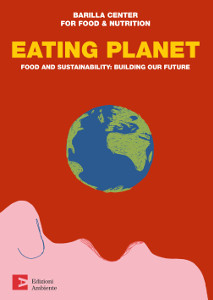
Eating Planet
Photos: Barilla Center for Food and Nutrition
Obesity costs the global economy $2 trillion annually. Contrasting that food waste costs another $2.6 trillion globally, according to the U.N. Food and Agriculture Organization (FAO). To put the issue of food into a human perspective 795 million people are believed to suffer from hunger or famine while at the same time 2.1 billion people are obese or overweight, according to the Barilla Center for Food & Nutrition Foundation in Italy. The organization and its members are among the high level thinkers across the globe concerned about the issues of food and nutrition.
In late February 2016, the Foundation launched the new edition of Eating Planet: Food and Sustainability: Building Our Future designed to provide “a comprehensive tool summarizing business perspectives on the global problems of food sustainability.” The first edition was published in 2012.
“These proposals can now be used as a starting point to truly correct the imbalances and distortions that are affecting the planet and the life of every one of us,” said Paulo Barilla, vice president, Barilla, in a promotional email about the book.




Contributing authors (left to right) Danielle Nierenberg, Barbara Buchner Matt Russell and Paolo De Castro
The report, to be published in several languages, focuses on the need for decision-making tools to guide research and innovation in the sector. The various authors suggest priority initiatives for decision makers and citizens, including many initiatives that have already been established by BCFN’s other action platforms such as the Milan Protocol and the Youth Manifesto.
The 301-page English language edition is divided into four main sections: Food For All, Food for Sustainable Growth, Food for Health, and Food for Culture. It is peppered with colorful photos and graphics.
Among the numerous contributing authors are Barbara Buchner, head of Climate Policy Initiative in Europe; Paolo De Castro, Italian politician, economist and agronomist; Carlo Petrini, president, Slow Food; Ricardo Uauy, professor, Public Health Nutrition at the Institute of Nutrition and Food Technology; Shimon Peres, President of Israel from 2007 to 2014; and Danielle Nierenberg, president, Food Tank.
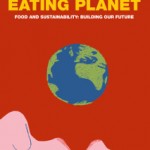
Click to buy Eating Planet – english edition
Comments:
Filed Under: Books
Posted by Elena del Valle on April 20, 2016

Unilever 100porcientotu campaign image
Photos: Unilever
To promote its Personal Care brands among Hispanics on social media Unilever staff launched #100PorCientoTu, a new bilingual campaign designed to promote “self-expression and individuality” in 2016. In developing the campaign executives relied on research from the company’s Consumer Marketing Insights (CMI) team.
Company representatives declined to identify details such as campaign elements or specific channels, except to say that it “will be supported by earned and paid media.” Planned components to date are the sponsorship of Nicky Jam’s The Fenix Tour concert in New York City and the Hispanicize conference in April.
“With #100PorCientoTu, Unilever is merging two Latino passion points, music and style, to inspire Latinos to be their best selves, always,” said Brian Critz, brand director, Multicultural for Unilever U.S. by email forwarded via the company’s public relations company. “At Unilever, we’ve adopted a total market approach to reaching Latino consumers, recognizing that there is a wide range of nuance when connecting with Latinos.”
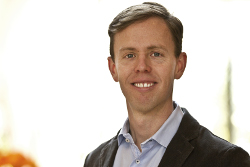
Brian Critz, brand director, Multicultural for Unilever U.S.
When asked about the target audience for the campaign he said, “With the #100PorCientoTu campaign, we want to celebrate the diversity and dynamism of the Latino community in the U.S., especially among millennials, whose identity is deeply tied to their culture, self-image and aspirations.”
Unilever hired a team of beauty and grooming influencers and experts like Denise Bidot, described as an international plus sized model, and Marcos “Reggae” Smith, described as a celebrity barber, and Leonardo Rocco, described as a celebrity stylist, to provide their views on beauty and grooming trends and tips at the campaign’s English language website, 100PorCientoTu.com. Some of the company’s Personal Care brands are Axe, Dove, Suave, Pond’s, TreSemme, Degree and Caress.
According to a recent company press release, Unilever is a leading supplier of Food, Refreshments, Home and Personal Care products with sales in more than 190 countries and reaching 2 billion consumers a day. In the United States, some of its brands are: Axe, Ben & Jerry’s, Breyers, Caress, Clear Scalp & Hair Therapy, Country Crock, Degree, Dove personal care products, Fruttare, Good Humor, Hellmann’s, and I Can’t Believe It’s Not Butter!; Unilever employs approximately 8,000 people in the United States; and in 2015, the company generated more than $8.5 billion in sales.
Posted by Elena del Valle on April 15, 2016
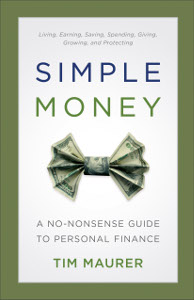
Simple Money
Photos: PR by the Book
Tim Maurer, director of personal finance, at Buckingham and the BAM Alliance, helps a team of 350 financial advisors nationally focus on the personal, non-numerical elements of financial advisory work such as behavioral finance, client interaction and communication. He dedicated a little over a year from idea to publication to Simple Money A No-Nonsense Guide to Personal Finance (BakerBooks, $15.99), a 285-page softcover book published this year, hoping, he says in the first chapter, for readers to find contentment, a richer life and a freer mind through the book.
When asked by email via his publisher how he defines simple money, he said: “Money management is complex because we are complex. Therefore, it is in better understanding ourselves that we are able to make even the most confounding financial decisions simple.”
The book is divided into 21 chapters and five parts: Planning for Life, Planning for Today, Planning for the Inevitable, Planning for the Unexpected and Planning for Action. He wrote the first two parts of the book, Planning for Life and Planning for Today, for all readers. The remainder he wrote for those curious about a particular topic like investing, life insurance, retirement planning or estate planning. He starts outlining four basic concepts: Personal finance is more personal than it is finance; We need to know why; Simple not simplistic; and Enough is “enough.”
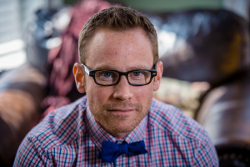
Tim Maurer, author, Simple Money
“For many years, I’ve said that ‘personal finance is more personal than it is finance,’ a statement that resonates anecdotally with most,” he said when asked why he wrote the book. “But my research more recently, especially in the field of behavioral finance and the science of motivation, has proven the statement to be scientific fact. This inspired me to synthesize the best of behavioral finance and use it as a lens through which to reexamine personal finance. The challenge, of course, was in making it ‘simple’ enough to be practical. But that’s always been my passion.”
The biggest challenge he faced writing the book was that, “Although it’s not the first time I’ve shared it, I give the most detailed rendition to date of the story of my near-death car accident that forever shaped my view of life, work and money,” he said. “It’s an important story, and it’s good for me to tell it, but it’s not necessarily easy.”
Each chapter begins with an explanation of what makes the topic relevant to the reader and ends with summary points. In the book, he says that “One of the ways we can make financial decisions simple is to genuinely understand what motivates us.” He goes on to say that although motivation is at the root of what we want too often it remains separate from our financial planning.

Click to buy Simple Money
Comments:
Filed Under: Books
Posted by Elena del Valle on April 6, 2016
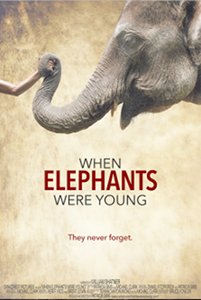
When Elephants Were Young
Photos, video: canazwest pictures
Canadian filmmaker Patricia Sims cares about endangered Asian elephants, a great deal. She and her collaborators dedicated five years to filming elephants and elephant handlers in Thailand at the end of which they produced When Elephants Were Young, an 86-minute documentary narrated by actor William Shatner. The film, in English and Thai with subtitles, will show at 5:30 p.m. April 8 at the Cinemark Palace, 3200 Airport Road, Boca Raton, and 12 noon April 13 at the Parisian 17, 545 Hibiscus St, West Palm Beach, as part of the Palm Beach International Film Festival in Palm Beach County, Florida.Scroll down to watch a trailer of the film.
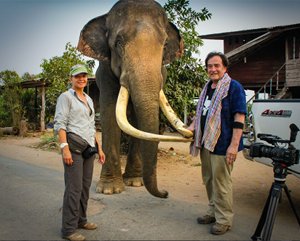
Patricia Sims and Michael Clark dedicated five years to the project
The film follows Wok, a young man, and Nong Mai, his young captive elephant, in their struggle to make a living begging on the streets of Bangkok, Thailand. When the opportunity arises to release Nong Mai to the forest Wok must decide, torn between his affection for the elephant who is also his only source of income, what is best. Can an elephant who has only known a life of captivity survive in the wild? The film zooms into the daily lives of its protagonists, examining the paradoxes of elephants in captivity.
According to Sims, When Elephants Were Young will appear in theaters across North America on World Elephant Day, August 12, 2016. Theater listings should be available in June. Around that same time it should become available globally on various video on demand platforms such as iTunes and Amazon. In Canada, it is slated for broadcast on the CBC Documentary Channel in fall 2016.

Asian elephants in Thailand from the film When Elephants Were Young
“There were many, many challenges, as is often the case with independent documentary filmmaking!” Sims said by email when asked about the biggest challenge she faced in the making of the film. “For sure, funding was a big challenge, and continues to be so even for this release stage of the film. There are many costs required to release our film, or any film, to the public. Often people are surprised to learn what is involved in the distribution stage for independent film, and what it takes to get a film out to the world.”
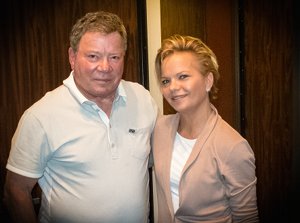
Patricia Sims, director, and William Shatner, narrator, When Elephants Were Young
The film’s budget was under one million dollars. Sims relied on “a combination of self-funding, crowd-funding, and private funding and a lot of in-kind support from many generous people who wanted to help us tell this story, and support the elephant cause.”
When asked about the rewards and surprises along the filmmaking journey, she replied, “We’ve had many amazing surprises and rewards with this film! Unfortunately, I can’t mention what they are here because it will ruin the ending of the film’s story. People will have to watch the film to see what our biggest surprises and rewards have been!”
Sims was director and producer and she co-wrote the documentary with Michael Clark. She has a passion for large-brained megafauna such as dolphins, primates, and elephants. She and the Elephant Reintroduction Foundation launched World Elephant Day on August 12, 2012.
As technology activist, cinematographer, and editor, Clark has employed his talents to portray the interconnectivity of life on this planet. He has won international awards for his work and his credits range from documentaries to episodic television, commercial and feature film productions. He seeks “to use digital and traditional media to inspire awareness, awe, and action for a mirthful, sustainable future.”

























